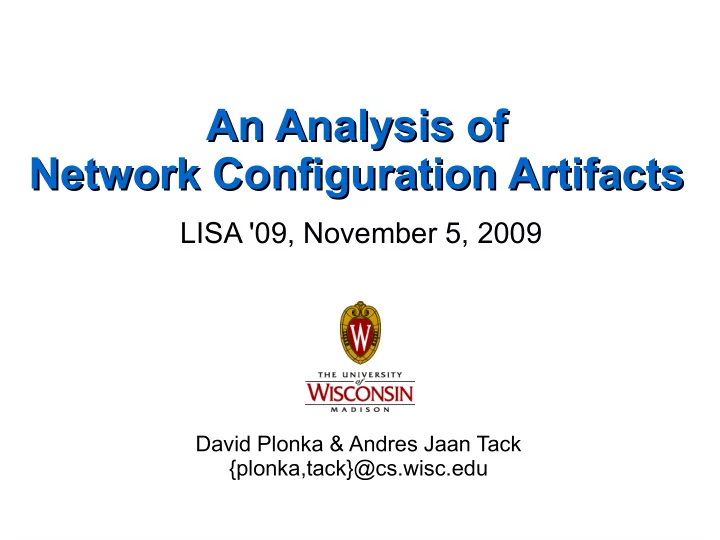

An Analysis of An Analysis of Network Configuration Artifacts Network Configuration Artifacts LISA '09, November 5, 2009 David Plonka & Andres Jaan Tack {plonka,tack}@cs.wisc.edu
Motivation and Goals ● Like software quality, network reliability is evolving: – Expectation of high availability, increasing reliance – Increasing numbers of skilled practitioners – Increasing level of automation
Motivation and Goals ● Like software quality, network reliability is evolving: – Expectation of high availability, increasing reliance – Increasing numbers of skilled practitioners – Increasing level of automation ● However, the management of networks and the Internet has not received similar attention to the development of software.
Motivation and Goals ● Like software quality, network reliability is evolving: – Expectation of high availability, increasing reliance – Increasing numbers of skilled practitioners – Increasing level of automation ● However, the management of networks and the Internet has not received similar attention to the development of software. ● We propose an analogy-based analysis , and that these elements are akin to each other: – Networks : Software Systems – Network Engineering : Software Engineering – Network Operators : Programmers
Campus Network
Network Artifacts ● artifact - an object created by humans, especially one remaining from a particular period ● Network Performance Measurements ● Network Management Systems' Topology ● Trouble Tickets ● Network Device Configurations – Routers, switches, firewalls – Network practitioners use Source Code Management (SCM) of device configurations for: – Configuration backups – Communicating changes
Network Configuration Repositories
Networks Studied
Mining SCM Repositories - Why? ● While successful in the PL community, this hasn't been leveraged in the context of network configuration and management. ● To visualize and elucidate network operation with the goal of understanding and improving the practice.
Mining SCM Repositories - How? ● Convert existing custom network version control system repositories to common CVS repositories. ● Use existing tools from the Programming Language (PL) and open source developer communities, e.g.: – StatCVS-XML – cvs2cl (CVS to ChangeLog) ● Perform additional static file analyses, e.g.: – Syntax-aware statistics (i.e. config stanzas) – Revision lifetimes
Configuration Files / Code Sample version 12.2 no service pad service timestamps debug datetime localtime service timestamps log datetime localtime service password-encryption ! hostname s-bldg-5-2-access ! spanning-tree mode rapid-pvst no spanning-tree optimize bpdu transmission spanning-tree extend system-id !
Code Sample (2) interface FastEthernet1/0/1 description sample 100Mbps ethernet interface switchport access vlan 42 switchport mode access ip access-group nodhcpserver in snmp trap mac-notification change added snmp trap mac-notification change removed no snmp trap link-status no mdix auto spanning-tree portfast spanning-tree bpduguard enable spanning-tree guard root
Code Sample (3) ip access-list extended nodhcpserver remark Id: ndhcp.acl,v 1.2 2005-05-20 11:26:03 ashley Exp deny udp any eq bootps any permit ip any any ! access-list 5 permit 192.2.0.1 access-list 5 remark Allow foo, bar, and baz servers access-list 5 permit 192.2.0.10 access-list 5 permit 192.2.0.11 ! ... !
Campus File / Device Count
Campus LOC by Topology
Campus LOC per Module
Campus Size Per Author
Campus Size Per Group
Campus Commits by Hour
Common Commit Comments
An Anomaly
Web-based Network Administration
Evaluating Practitioner Effort ● Measurements of practitioner effort – How often are “fixes” introduced? – How often do configurations change? – “Bad Days” (are Friday checkins more buggy?) ● Look toward improvements: – Syntax-aware revision analysis (stanzas) – How do we direct tool development?
Campus Commits by Day
Revision Lifetimes ● How long does a revision last before it is next modified? – Suggests the modus operandi of practitioners – Suggests the value or the staying power of a revision – Might also suggest some measure of network volatility
Campus Revision Lifetimes (<3.5 days)
Campus Revision Lifetimes (<10 min)
% Short-Lived Revisions by Day 8 7 6 5 4 Service Provider Campus 3 2 1 0 Sun Mon Tue Wed Thu Fri Sat
% Short-Lived Revisions by Day (Campus 25 Drill-Down) 20 15 agents contract field net noc 10 5 0 Sun Mon Tue Wed Thu Fri Sat
Campus Average File Size
Service Provider Average File Size
Campus Revisions by Stanza Type
Some Conclusions ● With varying device types, LOC is an erratic metric for the stanza-based, declarative network configuration language, (such as Cisco IOS) ● Analysis of network configurations exposes pertinent network management details including: – Group behaviors – Outstanding practitioners – Change times – High level of user compliance, but some curiosities – Tool-based efficiencies both expected and invented
Contributions ● An initial application of software development analysis tools to network operations based on existing, freely-available tools ● Beginnings of a network operations-specific measurement of practitioner effort to guide tool development, such as SCM and IDE-like tools for network operators ● In our case studies, this analogy-based analysis approach shows promise based on feedback by expert interviews.
Discussion and Future Work ● As in software, can we identify and investigate code decay, refactorings, and code clones? ● Leverage other artifacts to measure practitioner compliance and network service reliability and performance. ● Develop a complexity metric based on stanzas and inter-stanza references. (see Benson, et al., NSDI 2009)
An Analysis of An Analysis of Network Configuration Artifacts Network Configuration Artifacts LISA '09, November 5, 2009 David Plonka & Andres Jaan Tack {plonka,tack}@cs.wisc.edu
Recommend
More recommend